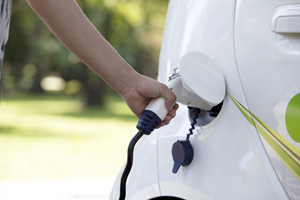Electric vehicles: Recharging in private

Electric vehicles require frequent recharging, which presents challenges for privacy and data protection. © Mihajlo Maricic/iStock/Thinkstock
Electric vehicles are becoming more popular due to their environmental credentials and relatively low running costs. However, most existing electric vehicles need to be recharged every 100 to 150 kilometers, with each recharge potentially exposing information related to a customer’s payment and location. Now, researchers at A*STAR have described a new system that would allow quick and easy money transfers at electric vehicle charging stations, without jeopardizing customer privacy.
“Cybersecurity is an important factor for payment systems, but it is often ignored by users or administrators until the system is being attacked,” says researcher Joseph Liu from the A*STAR Institute for Infocomm Research in Singapore[1]. “No one should have their daily habits or behavior traced without their consent.”
The recharging of electric vehicles presents unique challenges for privacy, not least because some cars with solar panels are able to sell electricity back to the grid, meaning payments flow in both directions. Without tight security, payment companies or hackers could monitor where and when cars are charged, gaining insight into people’s lifestyles that could be exploited for targeted spam marketing.
“Some popular electronic payment systems like credit cards do not provide any privacy, while other systems like prepaid cash cards may not be suitable for large payments, or are not insured against card loss,” says Liu. “Cash is anonymous, but requires expensive machines to keep cash stores secure from thieves.”
The new system developed by Liu and co-workers is based on an in-car unit that resembles a smartphone or tablet and, along with a range of security benefits, allows two-way anonymous payments for recharging. Users can instantly shut down their accounts and retrieve unused credit. Also, if their car is stolen they can revoke the location privacy to help police trace the car. In the event of a dispute between a user and a supplier, either party can submit the claims to an independent judging authority for investigation.
The researchers tested their system by simulating three different types of attack: a hacker trying to track the transactions of an honest user, a user trying to underpay for services, and a supplier trying to slander an honest user. The system proved robust against all three attacks.
The team has now implemented a prototype of their secure charging system. They will install the tamper-proof in-car units on a fleet of 100 new electric vehicles that will arrive in Singapore later this year, thanks to collaboration with the Chinese carmaker BYD Auto.
Reference
1. Au, M. H., Liu, J. K., Fang, J., Jiang, Z. L., Susilo, W., Zhou, J. A new payment system for enhancing location privacy of electric vehicles. IEEE Transactions on Vehicular Technology 63, 3–18 (2014).
Media Contact
All latest news from the category: Power and Electrical Engineering
This topic covers issues related to energy generation, conversion, transportation and consumption and how the industry is addressing the challenge of energy efficiency in general.
innovations-report provides in-depth and informative reports and articles on subjects ranging from wind energy, fuel cell technology, solar energy, geothermal energy, petroleum, gas, nuclear engineering, alternative energy and energy efficiency to fusion, hydrogen and superconductor technologies.
Newest articles

Superradiant atoms could push the boundaries of how precisely time can be measured
Superradiant atoms can help us measure time more precisely than ever. In a new study, researchers from the University of Copenhagen present a new method for measuring the time interval,…

Ion thermoelectric conversion devices for near room temperature
The electrode sheet of the thermoelectric device consists of ionic hydrogel, which is sandwiched between the electrodes to form, and the Prussian blue on the electrode undergoes a redox reaction…

Zap Energy achieves 37-million-degree temperatures in a compact device
New publication reports record electron temperatures for a small-scale, sheared-flow-stabilized Z-pinch fusion device. In the nine decades since humans first produced fusion reactions, only a few fusion technologies have demonstrated…





















